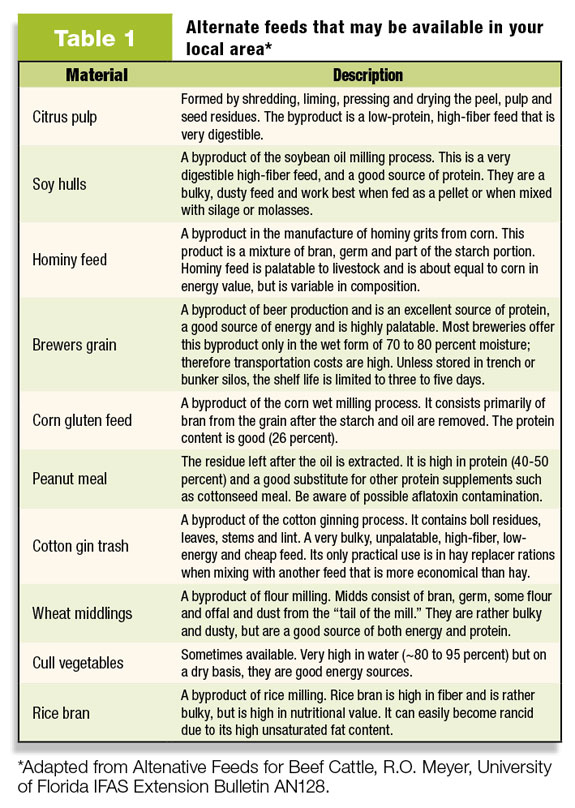Many ranchers ran out of grass during 2011, partly because they were overstocking their pastures before the drought began.
When the grass was gone, a decision had to be made on whether to liquidate the entire herd or try to keep the best breeding stock and feed them in a drylot until pastures recovered.
If breeding stock was retained the question became: “Which feeds are affordable yet provide the nutrients cattle require to maintain their body condition?”
The basic needs
The basic objective in the plan should be management of range and pastures so forage supplies become more resistant to drought through conservative stocking rates.
Rain following last year’s drought produced good pasture recovery on Southwest ranches where stocking rates were balanced with available forage.
Pastures grazed to bare ground will take two or three years or longer to recover, provided there is ample precipitation to promote vegetative growth. Producers with overgrazed pastures will continue to incur high feed costs.
“It is generally accepted that forage harvest under proper grazing can only be about 25 to 30 percent for grazing livestock,” says Bruce Carpenter, Texas AgriLife Extension livestock specialist at Fort Stockton, Texas.
“That is, for a given quantity of forage produced during a growing season, only 25 percent should go to livestock.
Other losses (insects, trampling, etc.) account for another 25 percent. If at least 50 percent of herbage production is left standing, research has shown that rainfall effectiveness can be doubled or even tripled during the next forage growth cycle.”
In severe drought, a certain amount of supplement will be required regardless of the grazing system. So what do you feed your cattle when drought takes the pasture?
This question is answered by exploring the available feed options and incorporating the most economic choices into the drought management plan.
The logical choice to replace or supplement pasture forage is hay, when it is affordable. Before feeding hay, however, take samples and send them to a laboratory for nutrient analysis.
Once you know the hay’s nutrient content, you can design a feed ration to meet the cow’s needs.
Designing the ration
Before designing a feed ration, you need to know the nutrient requirements of the animal.
For instance, Jason Cleere with Texas AgriLife Extension Service says that an 1,100-pound cow in late gestation, gaining about a pound per day, will consume 22 pounds of dry matter per day. She needs about 1.6 pounds of crude protein and 11 pounds of total digestible nutrients (TDN).
“When the 1,100-pound cow calves, her crude protein and energy requirements will increase,” states Cleere. “A lactating cow will consume 2 percent of her bodyweight per day or 28 pounds of dry matter.
Not only is more feed required, a higher-quality feed is needed. The animal needs an additional pound of crude protein and another three pounds of energy.
“Assume the hay analysis showed 8 percent crude protein and 52 percent TDN,” continues Cleere. “If you multiply the 8 percent protein times the 22 pounds of dry matter consumption, it is found that the late-gestation cow is eating 1.76 pounds of crude protein daily.
Since she only requires 1.6 pounds of crude protein, the animal’s requirements are being met with the hay.
“If you multiply the 52 percent TDN in the hay times the 22 pounds daily consumption, it is learned that the cow is consuming 11.44 pounds of TDN.
Since a dry cow requires 11 pounds of TDN daily, these requirements are being met. If the animal has good body condition, there is no need to feed anything but the hay.”
Calculate the costs
“With the continued high hay costs, we need to get creative in our feeding programs and think outside the box,” Cleere states. “Let’s assume we can buy cracked corn, which is about 10 percent more digestible than whole corn, from a feed store for $370 per ton.
Because corn contains more TDN than hay, one pound of cracked corn can be substituted for about 2.0 to 2.25 pounds of average grass hay.
“The equivalent cost of substituting corn is $168 per ton. This cost is calculated by dividing the corn cost of $370 per ton by the amount of replaced hay (2.25 pounds) for a value of $168 per ton.
If you pay more than $168 per ton for hay, you should consider making it last longer by adding corn to the ration rather than purchasing additional hay.
Feed rations should contain no more than 50 percent corn to keep cattle from developing acidosis and damaging their rumen walls.”
Other options
“Other feed options are corn stalks and sorghum,” says Cleere. “Corn stalks are a good source of roughage, but they should be analyzed for nitrate content.
They are low in protein – about 4 or 5 percent – and approximately 48 percent TDN. So you need to supplement them with a protein and energy source.
“When feeding sorghum, prussic acid won’t be a problem as long as the hay is properly cured. If you buy it immediately after harvest and you are going to start feeding it the next day, samples should be analyzed for prussic acid to determine if the sorghum is cured properly and the acid has dissipated.”
Whole cottonseed is fed regularly by producers, but they may not be an economical option when cotton yields are low.
Distillers grain can be lower-priced than corn; however, there is a limit to the amount that can be fed because of its high sulfur content.
Molasses-based liquids and tubs are viable feeds, but calculate costs and the convenience value before deciding to use them. Other feed options are listed in Table 1 below.
When writing and implementing a feeding plan, make forage conservation the primary objective.
Then complete the ration with the most economical feeds that meet the animal’s nutrient requirements. ![]()
PHOTO
Feeding from a sack becomes very expensive during drought. Consider alternate bulk feed sources that are more economical. Photo courtsey of Robert Fears.








